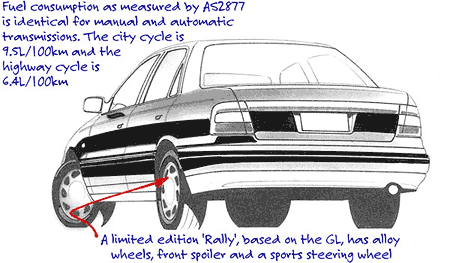BY MALCOLM LIVERMORE | 18th Jun 2003

The Lantra almost matched its Japanese rivals in these areas while remaining very competitive on price. This made it a strong contender in the four-cylinder, medium size class.
The Lantra was only available as a four-door sedan, with two equipment levels. The GL level has power steering and a radio/cassette. The GLS added electric windows and mirrors and central locking.
Extra cost equipment included air-conditioning, a glass sunroof and, unusually for these days, two-tone paint.
The Lantra remained on the market unchanged until superseded by a revised model in November, 1992.
The 1.6-litre, four-cylinder, twin overhead camshaft engine has four valves per cylinder and multi-point fuel-injection. The result is a decent power output of 84kW with 139Nm of torque at 4500rpm.
Transmissions are either five-speed manual or an optional four- speed automatic with a lock-up torque converter. A safety interlock prevents the engine starting unless the clutch pedal is depressed or, in the case of an automatic, the T-bar is locked in park until the brake pedal is depressed.
Suspension is by MacPherson struts and coil springs at the front and a torsion beam located by trailing arms with coil springs at the rear. A front stabiliser bar is used to reduce body roll.
Fuel consumption in day to day commuter use will range from 10 litres per 100km to 12.0L/100km and between 8.0L/100km and 9.0L/100km on the highway.
The low overall gearing of the transmission works well with the engine to make the Lantra feel nippy in typical suburban driving.
Brake, steering and suspension systems perform their respective tasks reliably and safely. The ride and handling compromise is biased towards ride comfort rather than outright handling and cornering.
A good set of tyres can transform the car's handling so watch for cheap rubber if the car does not respond particularly well.
The Lantra follows Hyundai's policy of making reliability and low cost a high priority. This means conservative engineering and well proven mechanical components have made durability and reliability one of the Lantra's strong points.
Spare parts are competitively priced, particularly when compared to some of Hyundai's Japanese rivals. When combined with the Lantra's record of reliability, service and maintenance costs are inexpensive.
The timing belt must be replaced at 96,000km. If it does fail from old age, the resulting engine damage is not cheap to repair.
The automatic transmission, like most these days, is a complex component and expensive to overhaul.
The Lantra is easily overlooked as it has not been a high volume seller like the smaller Excel. It is one of the better looking medium size sedans and well worth considering as a used car buy, but only if it's going very cheap and has been well-maintained.